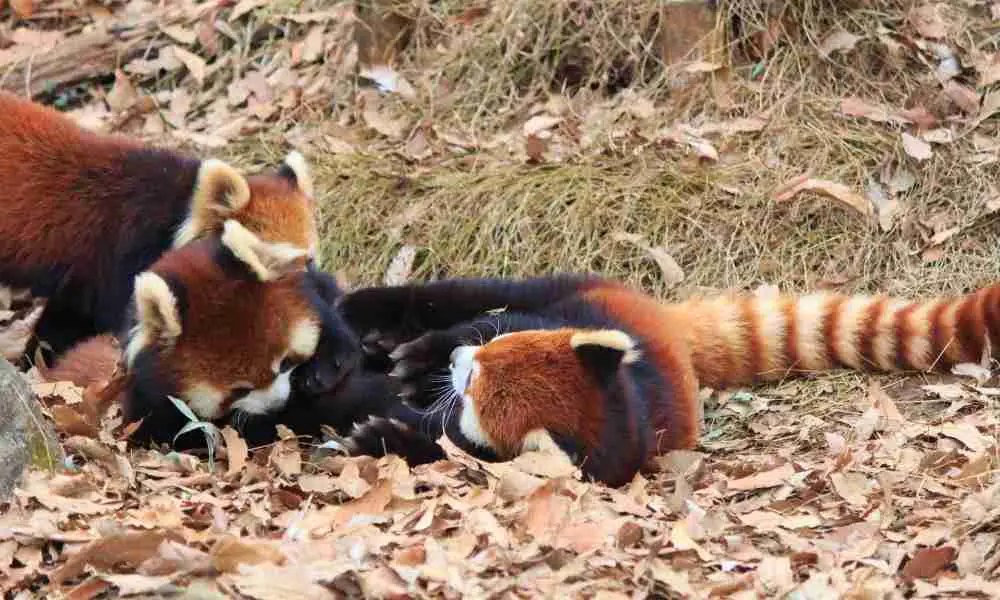Most animals have an evolutionary history. This normally involves changes and developments that help the animal adapt to their current lifestyle and environment.
Red pandas evolved too! But the question is, how have they evolved over the years?
Red pandas are bamboo-eating creatures that have evolved from meat-eating ancestors on their own.
And as they evolved, they developed pseudo-thumbs and other adaptations.
These adaptations suit their bamboo diet, lifestyle, and arboreal nature. Interestingly, red pandas have a unique evolution and are the perfect examples for evolution studies.
Of course, red pandas didn’t just become red pandas all of a sudden. They gradually evolved from their ancestors till they formed their own family Ailuridae.
But what exactly did red pandas evolve from?
Let’s find out next!
What Did Red Pandas Evolve From?
Red pandas evolved from ancient carnivoran ancestors of the Ailuridae family. These ancestors were meat eaters and this makes red pandas natural carnivores.
However, scientists have been able to find out only a little about these ancestors. Fossil evidence suggests they lived widely in Eurasia.
After red pandas evolved from their ancestors, they became the only extant members of the Aluiridae family.
What Are the Evolutionary Adaptations of the Red Panda?
Pseudo Thumbs (Sesamoid)

CTRO: scienceblogs.com
The major physical adaptation of the red pandas is the development of false thumbs on their front paws. However, this isn’t a thumb but an elongated wrist bone called a sesamoid.
These bones act like real thumbs, especially when it comes to gripping and holding stuff. They mostly evolved to help red pandas reach the thinnest branches while climbing trees.
Over the years, these pseudo thumbs have helped red pandas hold and handle bamboo pretty well. It makes eating bamboo much easier and faster.
Semi-Retractable Sharp Claws
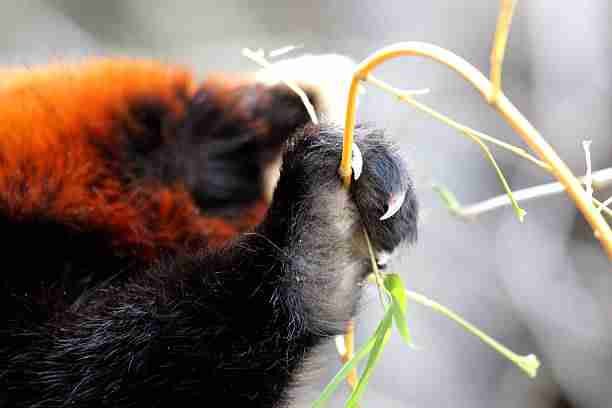
Red pandas have semi-retractable claws like cats. This is a carnivorous feature that comes in pretty handy when climbing.
These claws are very sharp and piece through trees. And this gives red pandas a good grip while they move from branch to branch.
It also prevents them from slipping off slippery tree branches. Interestingly, these claws give them the confidence to climb down a tree headfirst.
In addition, these claws are just built for climbing trees but also for defense. They are deadly and red pandas will use them to defend themselves from predators.
Bamboo Crushing Dentition
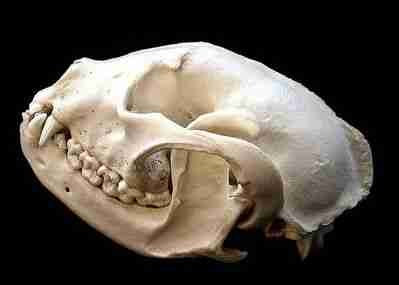
CTRO: pinterest.com
Red pandas have developed a unique set of molars to help them crush and grind bamboo. Their molars are large and flattened, with a detailed crown shape.
This makes them more adapted to grinding plants as tough as bamboo. It’s believed that the red pandas’ teeth weren’t always like this.
It must have evolved ever since red pandas lost interest in eating meat. Specifically, it meets the need for red pandas to eat and digest tough bamboo easily.
Extremely Flexible Ankles
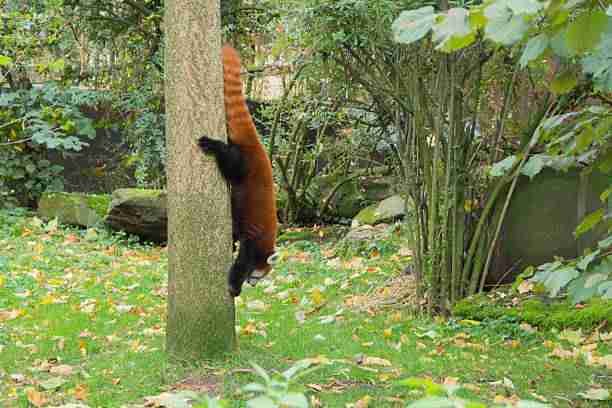
We say red pandas are skilled climbers. But more importantly, they have so many adaptations that make their climbing skills unmatchable.
If we’ll be missing out on any, we won’t miss talking about their flexible ankles. They have ankles that behave quite differently from any tree climber.
These ankles create a hind foot motion that allows red pandas to climb down trees headfirst. This motion involves the red panda rotating its ankles outwards.
As a result, their hind claws will hold tightly to tree trunks. Climbing down trees headfirst is faster.
Large Tails
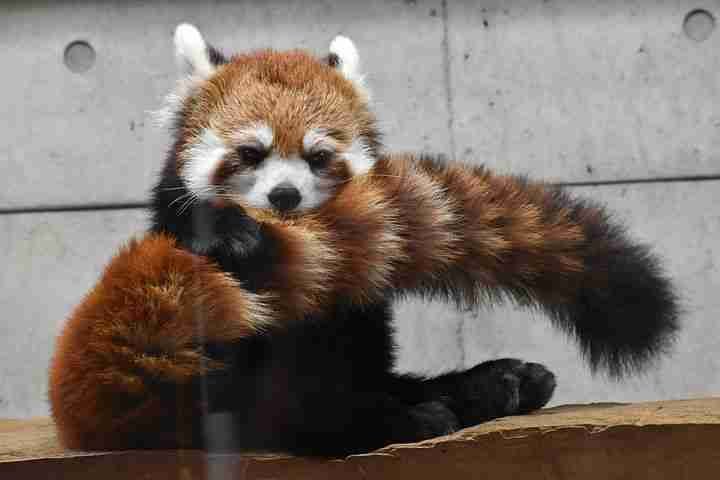
A red panda’s beautiful ringed tail isn’t just for show-off. It helps them in a lot of ways compared to the tails of other mammals.
As arboreal creatures, their broad tails help them maintain balance as they climb and move on narrow branches. This is similar to how tightrope walkers use poles to maintain balance.
Interestingly, these tails also support red pandas as they stand on their hind legs, which they do often. These tails act as props and can make them stay on two feet longer.
Their bushy tails also make comfortable pillows when they nap on tree branches. Additionally, the long and bushy nature of the tail makes it a good blanket.
During winter or chilly seasons, red pandas would wrap themselves with their tails. It keeps them warm and prevents heat loss.
Small Body Mass
Another adaptation of the red panda is its small body mass. They weigh around 7-13 lbs. (3-6 kg).
This kind of lightweight body mass allows them to easily climb and move on slim branches. This way, they can stay out of the reach of heavier tree-climbing predators in their habitat.
The Sense of Taste (Flehmen)
One of the red panda’s most unique adaptations is the Flehmen response (the sense of taste). With this, red pandas can taste the air.
They do this by pulling up their upper lips and breathing in through their mouth. Their nostrils remain closed while they do this.
Red pandas will mostly use this unique sense of taste to sense to feel and locate other red pandas around them.
Related Questions:
What is the Red Panda’s Nearest Fossil Ancestor?
Parailurus is the nearest fossil ancestor to red pandas. In addition to this, Parailurus is a genus of extinct carnivores belonging to the Ailuridae family.
Scientists believe they were about three species of the genus Parsilurus. They are:
- Parailurus Baikalicus
- Parailurus Anglicus
- Parailurus Tedford
Furthermore, these species spread widely throughout Eurasia (particularly Europe and Japan) and North America. This was about 3-4 million years ago.
Moreover, the Parailurus species were about twice the size of red pandas with larger heads and bigger jaws.
Do Red Pandas Still Eat Meat?
Yes, red pandas still eat meat, but on rare occasions. As they evolved over the years, they chose bamboo and plant foods over meat.
However, as natural meat eaters, they will hunt and feed on small animals—birds, insects, small lizards, etc.—in their environment.
Meat cannot be a red panda’s main food both in the wild and in captivity. They’ve lost so much interest in meat and depend mostly on bamboo for survival.
Why Were Red Pandas Given the Name Panda?
Red pandas were given the name panda due to their bamboo-eating lifestyle. The word panda came from the Nepalese words “nigalya ponya”, which translates to “bamboo eater.”
So the panda part of their name has nothing to do with being related to giant pandas. Funny enough, red pandas were the first to be named pandas.
This happened about 48 years before the discovery of giant pandas. This equally means they are the original pandas. And this makes them important.
How Many Species of Red Pandas Are There?

Red pandas are divided into two species. They are the Himalayan red panda (Ailurus Fulgens Fulgens) and the Chinese red panda (Ailurus Fulgens Styani).
Initially, they were considered subspecies. However, that changed after some genetic studies were made on them.
The studies proved that they are two separate species, not subspecies. They had so many morphological and DNA differences to be considered just subspecies.
And this brought about the need to reclassify them as separate species. The Himalayan red pandas mostly occupy the mountains of Nepal, Bhutan, Northern India, and Tibet.
Chinese red pandas, on the other hand, live in Sichuan and Yunnan provinces in China.
Final Thoughts
To sum up, red pandas have evolved in many ways to adapt to their new lifestyle. They evolved from carnivorous ancestors millions of years ago.
These creatures are the only living species of the Ailuridae family. Here’s more to remember about the red panda’s evolution:
- They developed pseudo thumbs to help them climb trees and eat bamboo.
- Their retractable claws keep them firm on trees as they move.
- Their tails offer them balance on trees and protect their bodies from cold during winter.
- Red pandas have very flexible ankles that help them climb down trees headfirst.
- The nearest fossil ancestor of the red panda is the Parailurus.
- Red Pandas never stopped eating meat; they still do but on rare occasions.
- As natural carnivores, red pandas’ digestive system breaks down meat much better than bamboo and other plants.
- There are two separate species (not subspecies) of the red panda.
We learned that the red pandas’ evolution happened many years ago. However, do you know when red pandas were first discovered as a species?
Find out all you need to know about the red pandas’ discovery in our article – Who Discovered Red Pandas?

